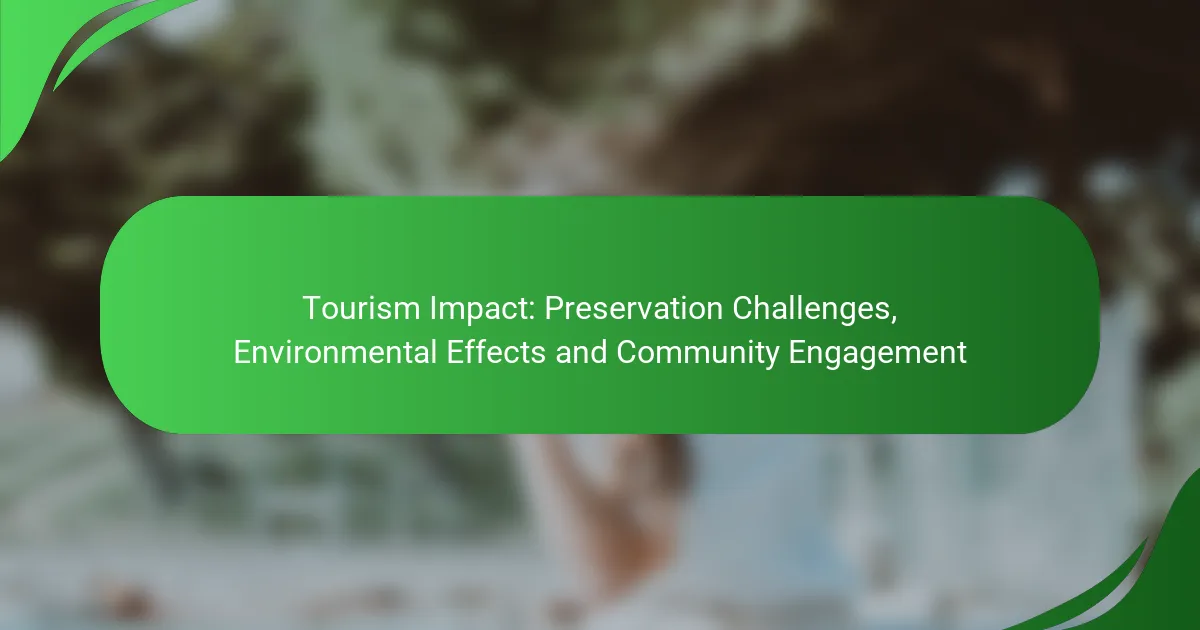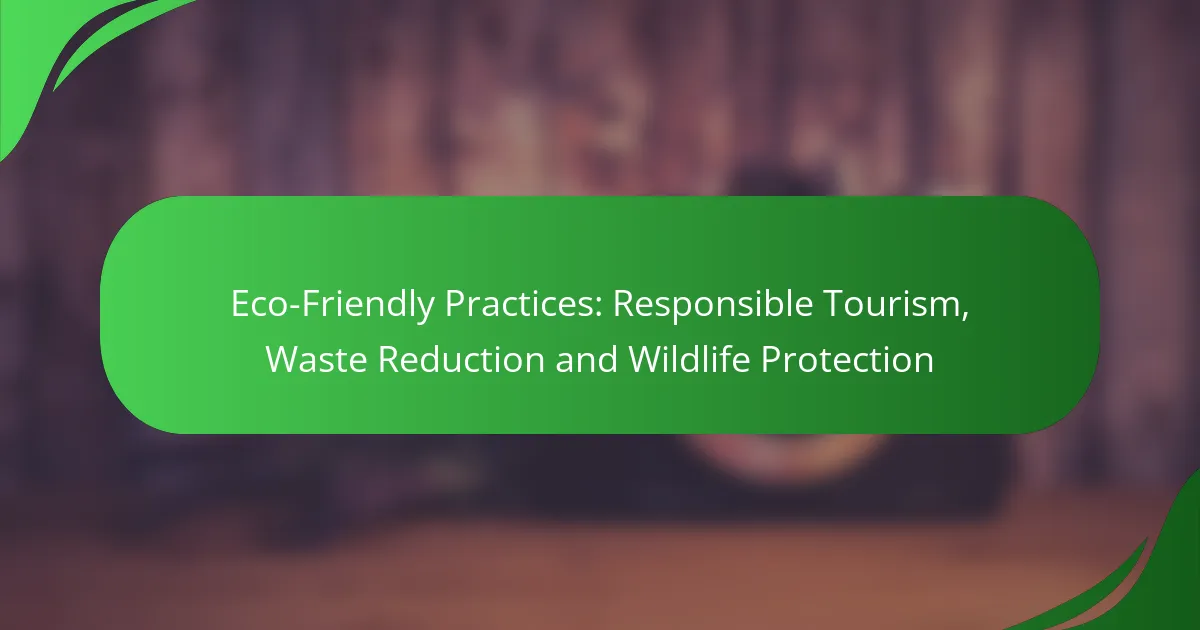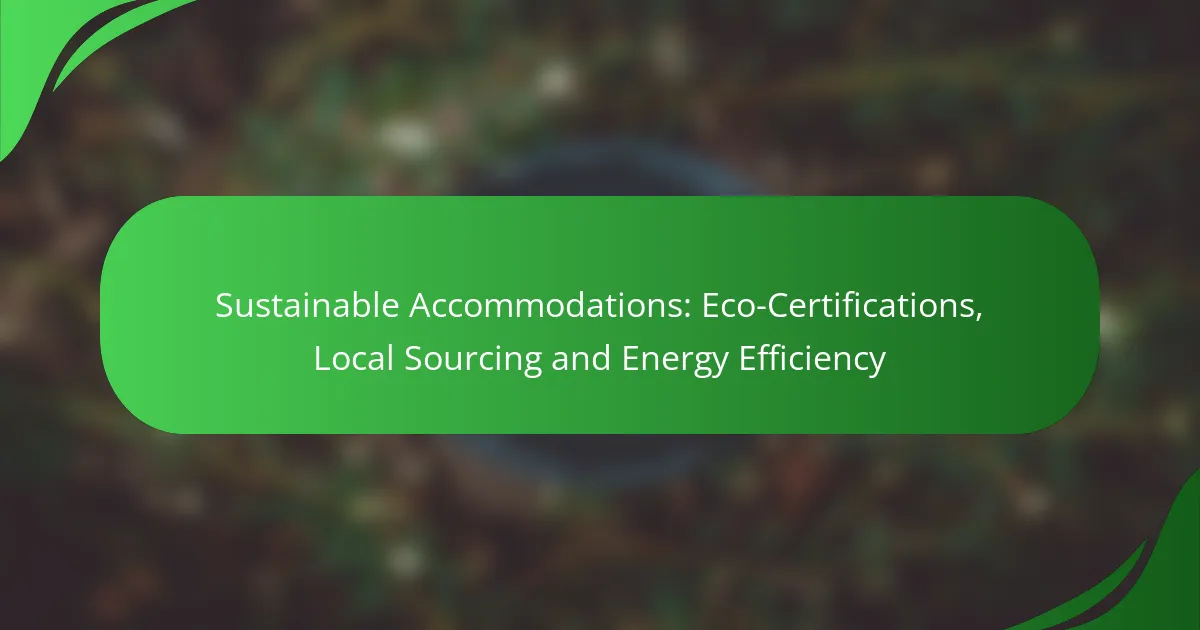The impact of tourism on environmental preservation presents a complex challenge, as increased visitor activity can lead to habitat degradation and pollution while straining conservation resources. However, sustainable tourism practices and community engagement can help mitigate these effects, ensuring that local ecosystems are protected and that the benefits of tourism are shared with residents. By adopting eco-friendly initiatives and involving local populations in decision-making, tourism can become a force for positive change rather than a threat to natural environments.
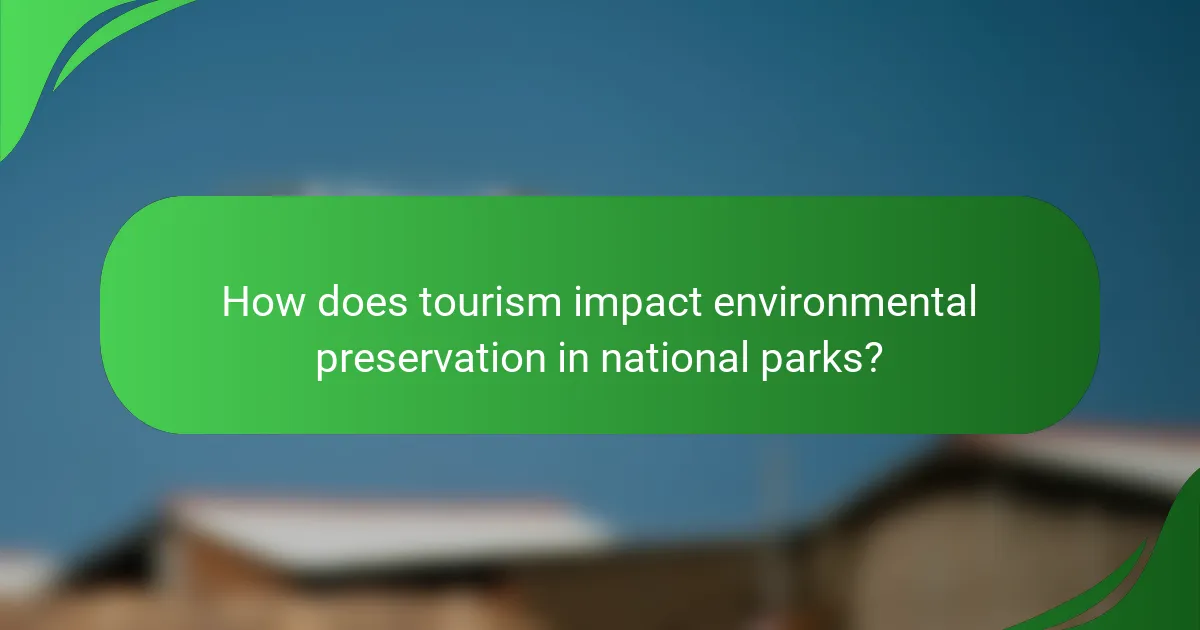
How does tourism impact environmental preservation in national parks?
Tourism significantly impacts environmental preservation in national parks by increasing human activity, which can lead to habitat degradation, pollution, and strain on conservation funding. While tourism can generate revenue for park maintenance, it often comes at the cost of the natural ecosystems that attract visitors in the first place.
Increased foot traffic leads to habitat degradation
High volumes of visitors can cause soil erosion, damage to vegetation, and disruption of wildlife habitats. Trails can become widened and more compacted, leading to a loss of native plant species and increased vulnerability of the ecosystem. Parks may implement measures such as designated pathways and visitor limits to mitigate these effects.
For example, some national parks have introduced seasonal access restrictions to sensitive areas during breeding seasons for local wildlife. This helps to protect critical habitats while still allowing tourists to enjoy the natural beauty of the park.
Pollution from tourism activities affects wildlife
Tourism-related pollution, including litter, noise, and water contamination, poses significant threats to wildlife in national parks. Animals may ingest harmful materials or be driven away from their natural habitats due to increased human presence and noise levels. This can disrupt feeding, breeding, and migration patterns.
To combat pollution, parks often implement strict regulations on waste disposal and encourage visitors to practice Leave No Trace principles. Educating tourists about the impact of their actions can help foster a more respectful interaction with nature.
Conservation efforts are often underfunded
Despite the revenue generated from tourism, many national parks face budget constraints that limit their ability to fund conservation efforts. This underfunding can hinder essential projects aimed at habitat restoration, wildlife protection, and infrastructure maintenance. The reliance on entrance fees and donations can create fluctuations in available resources.
To address funding gaps, some parks are exploring partnerships with non-profit organizations and local communities to enhance conservation initiatives. Engaging tourists in volunteer programs can also provide additional manpower and resources for preservation efforts.

What are the community engagement strategies in sustainable tourism?
Community engagement strategies in sustainable tourism focus on involving local populations in the planning and management of tourism activities. These strategies aim to ensure that tourism development benefits the community socially, economically, and environmentally.
Local stakeholder involvement in decision-making
Involving local stakeholders in decision-making processes is crucial for sustainable tourism. This includes engaging community members, local businesses, and government representatives to gather diverse perspectives and insights. Regular meetings and workshops can facilitate open dialogue and ensure that tourism initiatives align with community needs.
Effective stakeholder involvement often leads to better resource allocation and increased support for tourism projects. For example, a community may prioritize eco-friendly practices that reflect local values, enhancing both visitor experience and environmental conservation.
Community-led tourism initiatives
Community-led tourism initiatives empower locals to take charge of tourism development in their areas. This can include creating local tours, cultural experiences, or artisan markets that showcase regional heritage. By leading these initiatives, communities can ensure that tourism reflects their identity and generates income directly for residents.
Successful examples include cooperatives that manage eco-lodges or guided nature walks, allowing profits to remain within the community. Such initiatives not only boost the local economy but also promote sustainable practices that protect natural resources.
Education programs for tourists and locals
Education programs for both tourists and locals play a vital role in fostering sustainable tourism. These programs can inform visitors about local customs, environmental conservation, and responsible behaviors while traveling. Similarly, locals can benefit from training on hospitality, cultural preservation, and sustainable practices.
Workshops, guided tours, and informational materials can enhance understanding and appreciation of the destination. For instance, a local organization might offer workshops on traditional crafts, allowing tourists to engage meaningfully while supporting local artisans.

How can tourism mitigate its environmental effects?
Tourism can mitigate its environmental effects by adopting sustainable practices that reduce carbon footprints, conserve resources, and protect local ecosystems. This involves implementing eco-friendly initiatives, promoting alternative transportation, and encouraging responsible waste management among tourists and businesses alike.
Implementing eco-friendly practices in hotels
Hotels can significantly reduce their environmental impact by adopting eco-friendly practices such as using energy-efficient appliances, sourcing local and organic food, and implementing water conservation measures. For instance, installing low-flow showerheads and toilets can cut water usage by a substantial percentage.
Additionally, hotels can engage in green certification programs, which often require adherence to specific environmental standards. This not only helps the environment but can also attract eco-conscious travelers willing to pay a premium for sustainable accommodations.
Promoting low-impact transportation options
Encouraging the use of low-impact transportation options, such as public transit, biking, or walking, can greatly reduce the carbon emissions associated with tourism. Destinations can provide information on local transit routes and bike-sharing programs to facilitate these alternatives.
Travelers can also be incentivized to use electric or hybrid vehicle rentals, which are becoming increasingly available. Offering discounts or partnerships with eco-friendly transport services can further promote these options.
Encouraging responsible waste management
Responsible waste management is crucial for minimizing tourism’s environmental footprint. Destinations should implement recycling programs and provide clear signage to guide tourists on proper waste disposal. Simple measures like providing separate bins for recyclables and compost can make a significant difference.
Moreover, educating tourists about the importance of reducing single-use plastics and encouraging them to bring reusable items can lead to a notable decrease in waste. Local businesses can support these efforts by offering incentives for customers who bring their own bags or containers.
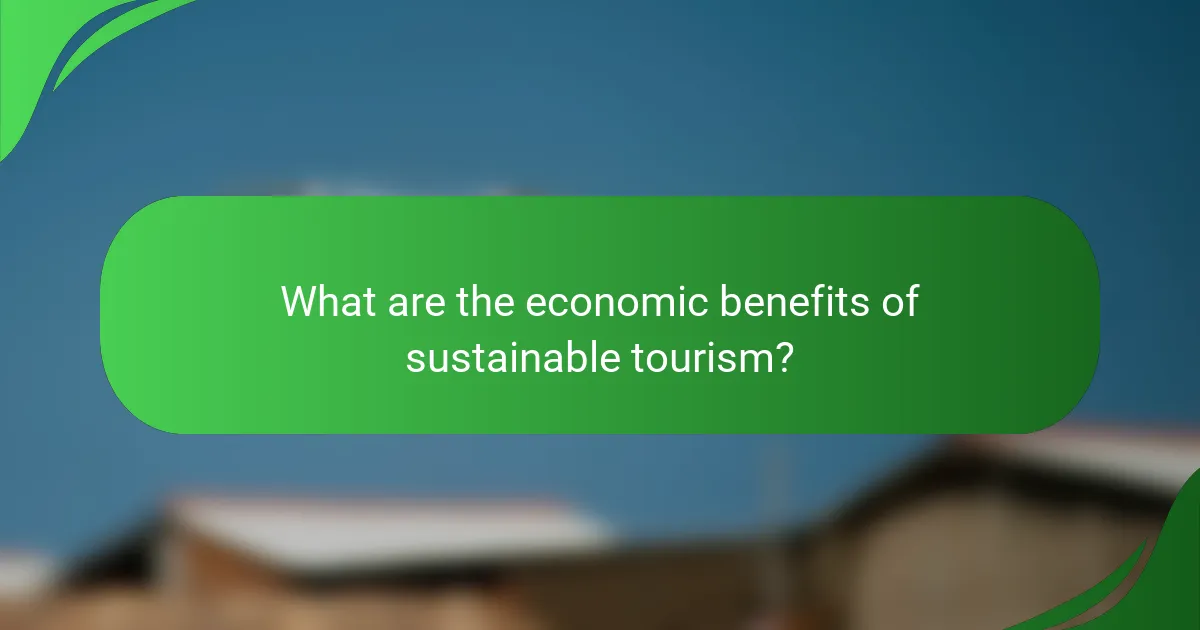
What are the economic benefits of sustainable tourism?
Sustainable tourism offers several economic benefits, primarily by fostering local economies while preserving natural resources. This approach not only creates jobs but also generates funding for conservation and supports local businesses, leading to a more resilient community.
Job creation in local communities
Sustainable tourism significantly contributes to job creation in local communities by providing employment opportunities in various sectors such as hospitality, guiding, and conservation. These jobs often require minimal qualifications, making them accessible to a broader range of individuals.
For example, eco-lodges and community-based tours can employ local residents, allowing them to earn a stable income while promoting their culture and environment. This employment can lead to lower unemployment rates and improved living standards.
Increased funding for conservation projects
Sustainable tourism generates increased funding for conservation projects through entrance fees, donations, and partnerships with non-profit organizations. This financial support is crucial for protecting natural habitats and wildlife, ensuring that tourism does not come at the expense of the environment.
Many destinations allocate a portion of tourism revenue to conservation efforts, allowing for the maintenance of parks and reserves. This funding can help preserve biodiversity and promote sustainable practices among local businesses.
Boosting local businesses through tourism
Sustainable tourism boosts local businesses by attracting visitors who are interested in authentic experiences and local products. This influx of tourists can lead to increased sales for restaurants, shops, and artisans, creating a vibrant local economy.
For instance, a community that promotes local crafts and foods can see a rise in demand, benefiting small-scale producers. By supporting local enterprises, sustainable tourism fosters economic diversification and resilience against market fluctuations.

What challenges do communities face in preserving cultural heritage?
Communities encounter several challenges in preserving cultural heritage, including the pressures of commercialization, the decline of traditional practices, and the need to maintain local identity amidst tourism growth. These factors can threaten the authenticity and sustainability of cultural sites.
Commercialization of cultural sites
Commercialization often transforms cultural sites into profit-driven attractions, which can dilute their historical significance. As businesses cater to tourist demands, authentic experiences may be replaced by staged performances or commodified souvenirs.
For example, in popular destinations, local artisans may shift from creating traditional crafts to mass-producing items that appeal to tourists, leading to a loss of genuine cultural expression. Communities must find a balance between generating revenue and preserving the integrity of their heritage.
Loss of traditional practices
The influx of tourism can lead to a gradual decline in traditional practices as younger generations may prioritize modern lifestyles over cultural customs. This shift can result in the erosion of languages, rituals, and skills that define a community’s identity.
To combat this, communities can implement educational programs that engage youth in traditional arts and practices, ensuring these customs are passed down. Collaborations with local schools and cultural organizations can help revitalize interest in heritage activities.
Balancing tourism and local identity
Finding a balance between attracting tourists and maintaining local identity is crucial for sustainable cultural heritage preservation. Communities must navigate the fine line between welcoming visitors and protecting their unique cultural attributes.
Strategies such as promoting responsible tourism, where visitors are encouraged to engage respectfully with local customs, can help. Additionally, community-led initiatives that involve locals in tourism planning can ensure that development aligns with preserving cultural identity.

How can technology support sustainable tourism practices?
Technology can significantly enhance sustainable tourism by promoting eco-friendly practices and improving resource management. By leveraging apps and data analytics, the tourism industry can better manage environmental impacts and engage communities effectively.
Use of apps for eco-friendly travel planning
Travel planning apps can help tourists make environmentally conscious choices by providing information on sustainable accommodations, local transportation options, and eco-friendly activities. For instance, apps like EcoTrip or Green Traveler allow users to filter options based on their environmental impact.
These applications often include features such as carbon footprint calculators, which help travelers understand the environmental costs of their choices. By encouraging users to select greener alternatives, these apps foster a culture of sustainability in tourism.
Data analytics for managing tourist flows
Data analytics can optimize tourist flows by analyzing patterns in visitor behavior and preferences. This information allows destinations to manage peak times and reduce overcrowding, which in turn minimizes environmental degradation and enhances visitor experiences.
For example, using data from social media and booking platforms, destinations can identify high-traffic areas and adjust marketing strategies or infrastructure accordingly. Implementing such analytics can lead to better resource allocation and improved community engagement in tourism planning.
